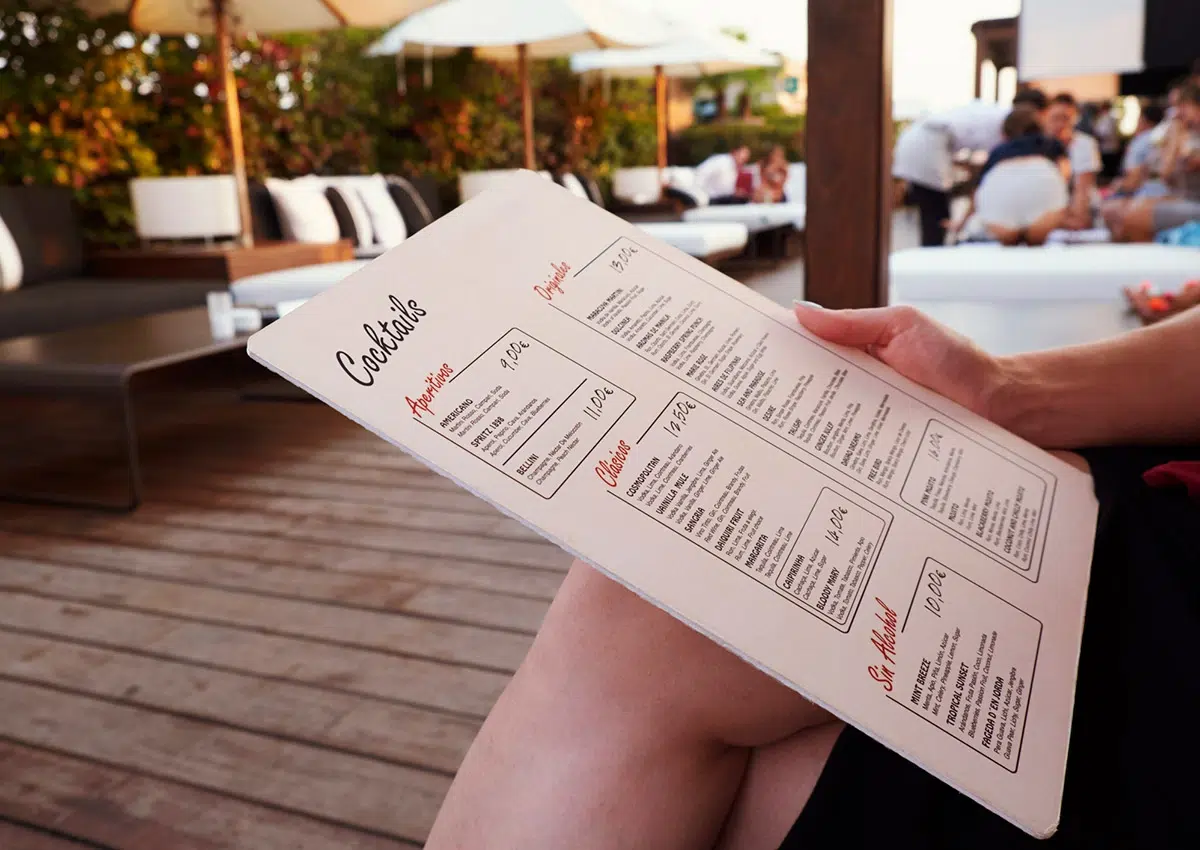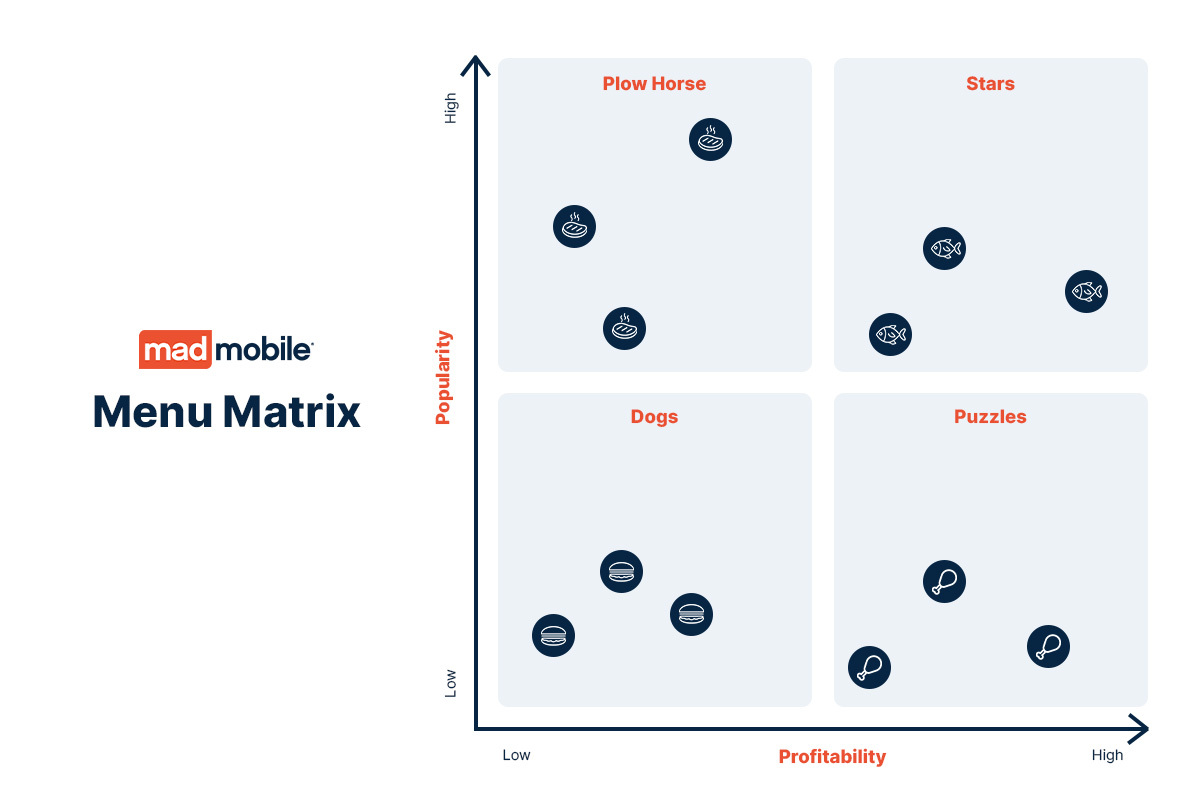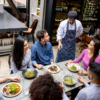Every restaurant needs a well-planned menu. While the listed dishes are the most prominent, many other elements impact your guests. From the general style down to minuscule details, everything you put on your menu is essential to your sales. To create the best design possible, you’ll need to perform multiple levels of analysis and engage in restaurant menu engineering.
You should put some time and effort into analyzing the way your menu functions and performs. According to Menu Cover Depot, one menu redesign could increase restaurant profits by up to 15% and even more with ongoing analysis. Menu analysis involves identifying each menu item’s profitability and popularity, as well as forming a strategy to enhance and improve the overall success and sales of your restaurant. The process doesn’t have to be difficult, but it should be ongoing.
There will always be shifts in trends, with design styles and the food itself. Everything from the font you choose to the item descriptions and the plates you offer will determine your success. When you pay attention to the way these evolve over time, you can adapt your menu to fit. Your consumer base should help shape the menu as well. The more you cater your menu to your customers’ preferences, the more they’ll want to come back.
What Is Menu Analysis?
Menu analysis focuses on understanding how your restaurant is functioning in terms of pricing and performance. It explores every facet of your menu, from the visual design to the psychology and calculated math behind it. The primary aim of the analysis is to identify each item’s popularity and profitability. The results will inform you as to how you should move forward to improve overall success.
When you have data about your sales, profits, customer base, and popular items to work with, you can create a new strategy to improve your profit margins. Your plan may include changing the look of your menu, altering prices based on several factors, using customer psychology, and adjusting the dishes you offer.
Conducting regular menu analyses is essential for several reasons. Consumer preferences are always changing, and if you want the best chance of success, you need to stay knowledgeable about current trends. Menu analysis will also help you keep an eye on your competition’s performance. When you look at trends in the scope of your surrounding market, you’ll have insights into what your competitors are doing well or what demands are unfulfilled.
The process can also help your staff. By making productive changes that increase your profit margins, you can afford to make minimum wage increases. You can also simplify your menu, creating a strong program that allows your kitchen staff to fulfill orders faster.
With a properly conducted menu analysis, you can improve multiple areas of your business at once. Whether you want to refresh customer interest, update your brand, or focus on increasing profits, your menu management is the answer.
Why Is It Important to Analyze and Update Your Menu?
Understanding how to calculate the return on investment (ROI) of each menu item gives you the opportunity to strategize a plan to develop more profitable items. One of the first things your customers interact with is a menu. It helps carry your brand and influences how much money the customer will spend, what they’ll order, and how high their expectations are. With careful consideration of all the elements that make up a menu, you can help your restaurant flourish through data-based engineering and psychology.
Most restaurant owners have goals in mind that they want to achieve, whether they pertain to profits, branding and design, customer retention, or any other area. Conducting a thorough menu analysis is essential to creating a strategy for improving your restaurant’s sales and success.
By taking a deep dive into your menu, you’ll see how your food costs and profit margins stack up. You should price each item you offer based on its food cost — the amount of money it takes to prepare it. Only then can you accurately tailor the profit margin on every dish.
Analyzing your menu will also give you insights into where you can make improvements and how you can work towards a more effective design. If certain aspects of your menu look outdated or disorganized, your customers are likely to spend less. Sleek, modern menu design can make your restaurant seem more classy or stylish, subconsciously convincing guests to spend more.
1. Adapting Menu Offerings
When it comes to how much time your customers spend looking at your menu, you only have a short span of their undivided attention. With this in mind, it’s easy to see why your offerings and menu organization is so important.
Creating a restaurant menu analysis report isn’t all about looking at cost-effectiveness or profit margins. It should be equally as much about your customers. If your menu has items that hardly sell, it may be time to replace them with something new and exciting. On the other hand, if there’s a particular dish your customer base orders frequently, it may be wise to make it stand out on your menu.
Every restaurant has its star dishes, along with the classic staples that don’t draw a ton of profit. When it comes to organization, the big sellers should stand out, either by placing them at the top of lists or using visual cues to draw the eye. Using a photograph of the dish can even boost your profits — when it’s the only picture on a page, the sales of that item can increase substantially.
Menu Matrix
Measuring the popularity and profitability of your menu items is essential in the analysis process. A menu engineering analysis from your back office system can optimize your menu items and ensure you’re only selling the products your guests love and are profitable.
It’s easiest to measure the popularity of your menu items by plotting them on the matrix below:
These 4 categories will help visualize the profitability vs. popularity of your menu items.
- Stars: high popular, high profitability
- Plowhorses: high popularity, low profitability
- Puzzles: low popularity, high profitability
- Dogs: low popularity, low profitability
Using these simple terms is a vital piece in restaurant operations. You need to make calculated decisions on what dishes you want to keep or remove; whether to lower or raise a price, change portion sizes or ingredients; and how to identify profitable items to increase sales of those dishes.
One way you can ensure you’re serving customers to the best of your ability is by integrating customer feedback into your process. This helps with consistent analysis and shows the customer you care about their experience.
2. Menu Aesthetics
From the content itself to the overall feel of the menu, creating the right aesthetic is essential to draw in the customer’s attention. Guests will remember if your menu is poorly designed, disorganized, or particularly unimpressive, but they’ll also recall if it’s well thought out. Also, aesthetics can help suggest them towards pricier decisions. Four of the most influential aesthetics of menu design are:
- Fonts: The font you choose for your menu can convey more than you think. Specific fonts give off an attitude. For example, serif fonts are a bit more classic and refined, while sans serif fonts are modern and readable. The fonts you choose also help the overall aesthetic and promote readability.
- Styles: When you take the time to reexamine and redesign your menu, the style matters just as much as the other elements. It’s an extension of your brand and a piece of advertising for your restaurant as a whole. The style includes everything from the colors you choose to the way you decide to layout items on a page. Several aspects of style can improve your business, including creative layout organization, use of color, and cohesiveness with your restaurant’s branding.
- Copy: All of the writing in a menu counts as part of the copy. Names of the dishes and descriptions are crucial parts of the menu copy, as they can affect a customer’s decision as well as their view of the restaurant as a whole. Descriptions should include language that plays to the guests’ senses, using vibrant wording that makes their mouths water even before ordering. With writing alone, you can express whether your restaurant is modern and trendy or angling more towards a classic feel.
- Icons: If you offer meals compatible with specialized diets, such as gluten-free, vegetarian, or vegan dishes, make them stand out. Placing small, understandable icons next to items will make them easily distinguishable and allow those with dietary needs to skim your menu.
Overall, the aesthetics will help you play to your customer base in a multitude of ways. Paired with the results of the analysis, you can see which menu items should have more emphasis than others and differentiate them using design elements. If you want to stay up to date with the most modern tech, you can even start implementing digital menus, which are both user-friendly and fast.
3. Menu Descriptions and Pricing Placement
Menu item descriptions and pricing styles both play a significant role in the customer’s decision — whether or not they actively know this is the case. With the item descriptions and pricing style alone, you can create an entire mood for your restaurant, as long as it plays off of your established branding.
Where some restaurants include full descriptions of their dishes, others choose not to. Some stay near the middle, only listing the ingredients. Whatever style you pick, it will reflect your establishment as a whole and speak to different demographics of customers. However, including item descriptions is an excellent opportunity to appeal to your visitors’ imagination and allow them to paint a picture of the meal before they order it.
Using creative phrasing can make your dishes more exciting, and they work to draw guests to the pricier menu items. Descriptors like freshly-baked, home-brewed, free-range, or hand-selected can make an entree seem more like a full experience. On the other hand, you can overdo it by using superlatives or overly-descriptive language. You can also use nostalgia to your advantage by adding names or family relations to the names of dishes — Aunt May’s Famous Baked Macaroni, for example.
As far as pricing goes, there’s a similar psychological influence to it. For one, removing the dollar signs from your menu may encourage guests to spend more money. It works by removing the perceived value of the dishes, making customers feel less like they’re spending money and basing their decisions more on taste than budget. Some restaurants go as far as to leave prices at a flat one or two-digit number or even spell out the cost.
Placement is also incredibly important. Many restaurants have the same organizational layout for their menus — lists of dishes with the item names on the left side of the page and prices on the right. However, this creates a column of prices down the right-hand side, making guests more likely to think more about cost and skim for the less expensive options. Instead, you should list the cost of each item at the end of its description, in the same size font. It’s less distinguishable, and your guests are more likely to make a decision based on taste.
The Benefits of Performing a Menu Analysis
Regardless of whether or not you’re looking to spruce up your menu, performing an in-depth analysis is beneficial in multiple ways. With the information you’ll collect, you can:
- Increase sales: Once you know how all your pricing and costs work out, you can focus on engineering your menu to increase sales. Menu engineering is the practice of pricing and designing a menu to benefit your restaurant. Strategically placing top-selling items and creating the menu to play to your customers’ psychology will bring in a more substantial profit. Restaurant analytics allow you to take action in these ways and develop a plan for how to improve.
- Keep a pulse on the competition: Menu analysis should also incorporate outside sources. It’s important to know how your pricing stacks up to your competitors. If your prices are too high on items that are readily available elsewhere, like a burger, consider lowering them. Unnecessary markup can cause customers to seek out your competition. If you are running an upscale establishment, higher pricing won’t be as much of a concern — rather, it’ll distinguish you from other nearby restaurants.
- Understand your profitability: Regardless of how you design your menu, you need to make a significant profit on your dishes. As with any restaurant, some of your offerings will bring in a higher contribution than others. Conducting an analysis will show you what brings in the most — and least — profit. By understanding what your top-sellers are, you can better design your menu to encourage customers to buy those dishes.
- Understand expenses and pricing: Understanding how your business operates is an essential part of carefully designing your menu. Between the cost of the goods you sell and pricing that works well in your market, you can cater to customer preferences while staying sharp on money matters.
- Recognize the latest customer trends: Your customers generate your profits. It’s essential to pay attention to their needs and wants, as they are why you can stay in business. Retention is a crucial part of running any business. By paying attention to the trends in your menu, you can see what people are most frequently purchasing and focus on that style of food or flavor.
While these are the base benefits of menu analysis for any restaurant, each establishment will have their own experiences with it. In some cases, you may learn something completely new about your customer base or find a flaw in pricing you hadn’t caught before. By performing analyses continually, you can keep up with shifts in all of these areas and optimize your menu to the best of your ability.
Menu Analysis Calculations
To create an effective menu, you need to understand the role of food cost calculations. Your restaurant should have a target number of total food cost, or how much money it takes to produce your menu items. However, each offering may have a different food cost percentage, which is the ratio of food cost to the item’s selling price. The margin between the two will vary by each dish, depending on what it’s made of or how well it sells.
You need to aim at creating a balance of high and low prices on your menu. It’ll offer a range for customers while allowing you to reach target food cost goals successfully. When it comes to calculating the costs of your menu items, there are several basic formulas you should be familiar with, including:
- Portion cost: Finding the portion cost of a menu item will provide you with a good baseline to work from. To find the price per portion, multiply the cost per pound of the main ingredient by the portion cost factor. You can use this number to calculate a menu price and ensure you don’t dip below your profit line. Formula: Portion size x unit serving cost = Portion cost
- Food cost percentage or cost markup: While these two calculations are similar, they’re expressed in two different ways. You can calculate food cost percentage by dividing the portion cost by the selling price. The equation for cost markup is the reverse — the selling price divided by the portion cost. Formula: Portion cost/Selling price = Food cost percentage or cost markup
- Selling price: Once you know your portion cost and cost markup, you can calculate an accurate selling price for the menu item by multiplying them. This equation will provide you with a minimum selling price to keep your markup margin. However, you can easily adjust the price to be higher or lower based on competitive pricing and the balance of the menu as a whole. Formula: Portion cost x Food cost percentage = Selling price
- Food costs: Determining food costs is slightly more complicated, as it involves factors outside of what’s on the plate. The calculation requires you to take your sales and subtract the sum of your estimated labor costs, overhead, and profit. While these are estimations, the projected cost will be more accurate than most other equations.
- Markup margin: You can find the markup margin for your menu items by dividing the number one by your food cost percentage. Whatever number you get from the calculation, you can multiply it by your portion costs to create a menu pricing with the same margin. If the price seems unreasonable, you may need to revisit your food costs, as one of your estimations may be off. Again, you can also raise or lower it based on market conditions and menu balance. Formula: 1/Food cost percentage = Markup margin
- Contribution margin: It’s reasonable to think that lower food costs mean a greater opportunity for a high-profit margin. While that thinking isn’t incorrect, it doesn’t translate well to calculating monetary profit. The contribution margin is a better measure, as it will help you determine the amount of profit that comes from each item. The equation is simple — subtract the item’s cost price from the selling price. In comparing two dishes, one could have a higher percentage for profit margin while the other has a higher monetary contribution margin. Formula: Selling price – cost price = Contribution margin
These calculations will help you balance your menu pricing and achieve your targets. In conducting a full menu analysis and creating harmony between your costs and pricing, you can accurately predict future sales and place supply orders. While this may seem like a lot of math, you can easily keep track of trends and percentages by investing in a reliable POS system or other menu engineering software.
Conclusion
Menu analysis is essential to running a successful restaurant. While it may seem like a large undertaking, you’ll have all the help you need with CAKE’s restaurant POS. With our menu management, you can collect and keep track of all the information you need to improve your menu design and pricing. Take on analysis with ease with our integrated user-friendly tools.
FAQs
How often should a restaurant conduct menu analysis to ensure it stays relevant in a dynamic market?
The frequency of performing a menu analysis may vary based on factors such as seasonal changes, shifts in consumer preferences, and menu updates. While some restaurants may perform analysis monthly or quarterly, others might opt for bi-annual or annual assessments to ensure their menu remains aligned with evolving trends and customer preferences.
Are there any specific strategies recommended for incorporating customer feedback into the menu analysis process?
One approach is to gather feedback through surveys, comment cards, or online reviews and analyze the data to identify patterns or trends in customer preferences. Restaurants can also engage with customers directly through focus groups or tasting events to solicit feedback on specific menu items or concepts. By integrating customer feedback into the analysis process, restaurants can make informed decisions about menu changes or improvements that resonate with their target audience.
In what ways can restaurants effectively integrate digital menus while maintaining a balance between traditional and modern approaches to menu design?
Restaurants can use different types of digital menus to maintain a balance between the methods of menu design, choosing what serves their goals best. Digital menus can help engage customers in-house and online by highlighting specials, promotions, or most popular items dynamically. They can enhance the dining experience by providing interactive features such as photos, videos, or detailed descriptions of menu items. It’s essential to ensure that digital menus complement the overall ambiance, niche concept, and branding of the restaurant without overshadowing the traditional dining experience. By integrating digital menus thoughtfully, restaurants can cater to modern consumer preferences while retaining the charm of traditional menu formats.








